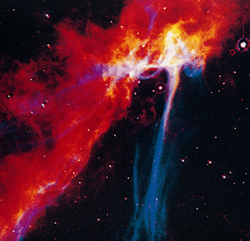Accumulating stellar ‘stuff’ to form galaxies
Looking up at the night sky, one might think the stars and their formations have been there forever and will be there forever. The truth is that the Universe is constantly changing albeit on an observationally slow scale, stars are born and die and galaxies are evolving. One phenomenon that appears to be involved in the growth of galaxies is accretion. Accretion is the attraction and accumulation of gas and dust onto compact objects such as stars and planets due to the gravitational pull associated with their large masses. It is accompanied by various forms of high-energy jet bursts observed as an increase in the object’s luminosity. Many galaxies have supermassive accreting black holes at their centre referred to as active galactic nuclei (AGN). Accretion onto black holes or neutron stars produces quasars in distant galaxies as well as extremely high-energy gamma-ray bursts and stellar X-ray binaries or bursts (XRBs). Astronomers have observed a so-called scaling relationship between the growth of AGN and growth of the galaxies themselves. More massive galaxies have more massive black holes. European scientists sought to extend their previous work on discovered scaling relationships between XRBs and AGN to produce a unified model of all accreting sources and to study phenomena regulating the growth of galaxies. With funding for the ‘Exploitation of the connections from X-ray binaries to active galactic nuclei’ (XRBGAL) project, the team pursued its goals. Investigators directly detected inefficient flows in XRBs and were able to experimentally explain prevalent underlying theories. They also demonstrated numerous observational similarities previously thought not to exist between accreting white dwarfs (WDs), another class of stars, and XRBs. Finally, using the scaling relationships developed, the team calculated mass limits of the black hole at the centre of the globular cluster NGC 6338. Understanding stellar and other galactic events through experimentation and numerical modelling provides insight into the origins and evolution of galaxies. The XRBGAL project yielded important observational and mathematical results vital to this understanding.



